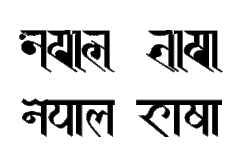Newar language
Sino-Tibetan language of central-eastern Nepal
Nepal Bhasa is a language spoken by indigenous Newa people of Nepal. It is a Himalayan language of Tibeto-Burman branch of the Sino-Tibetan languages group.
| Newa | |
|---|---|
| Nepal Bhasa | |
| नेवाः भाय् Newāh Bhāy | |
 The word "Nepal Bhasa" written in the Ranjana alphabet and the Prachalit Nepal alphabet | |
| Native to | Nepal |
| Ethnicity | 1.26 million Newa people (2001 census?)[1] |
Native speakers | 860,000 (2011 census)[2] |
Sino-Tibetan
| |
Early form | |
| Dialects | |
| Ranjana alphabets and various in the past, Devanagari currently | |
| Official status | |
| Regulated by | Nepal Bhasa Academy |
| Language codes | |
| ISO 639-2 | new Nepal Bhasa, Newari |
| ISO 639-3 | Either:new – Newarnwx – Middle Newa |
newa Nepal Bhasa | |
nwx Middle Newa | |
| Glottolog | newa1247 |
Newah Bhaaye is the term used for Nepal Bhasa by its native speakers. The term 'Newari' has been used in derogatory form to replace the original name of the language. [3]
Linguistics
changeNepal Bhasa shares the feature of Kirant and Tibetan dialects of Northern Himalayas. It consists of five major dialects and several sub-dialects spoken by Newa people living throughout the country.
References
change- ↑ Newa at Ethnologue (15th ed., 2005)
- ↑ Newa at Ethnologue (18th ed., 2015)
Middle Newa at Ethnologue (18th ed., 2015) - ↑ Kapali, Rukshana (2018-12-08). "Why using the word 'Newari' is problematic". Rukuchee Blog. Retrieved 2018-12-13.[permanent dead link]
Newari edition of Wikipedia, the free encyclopedia